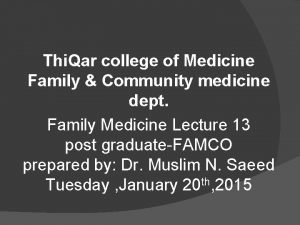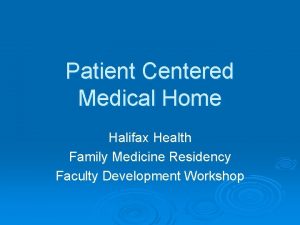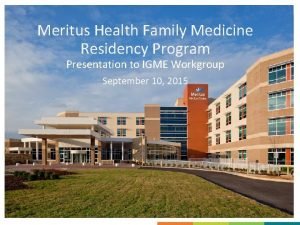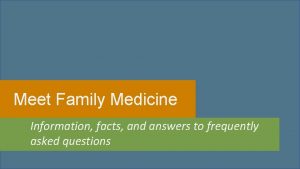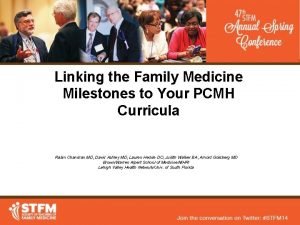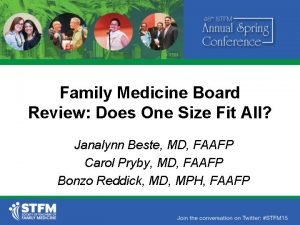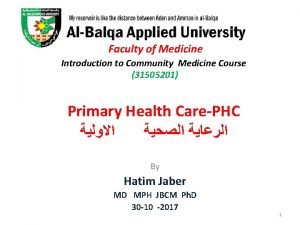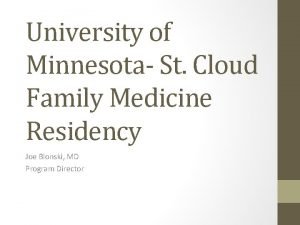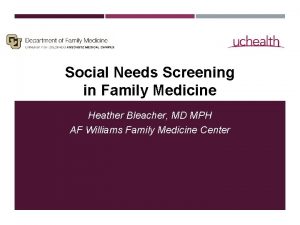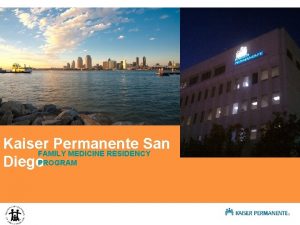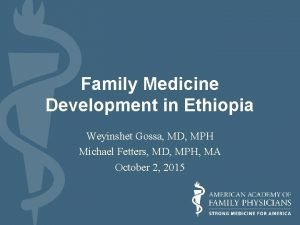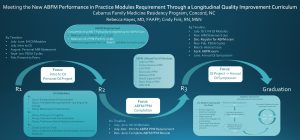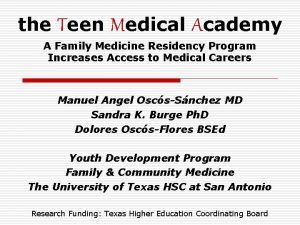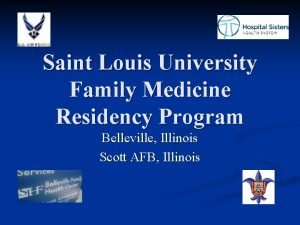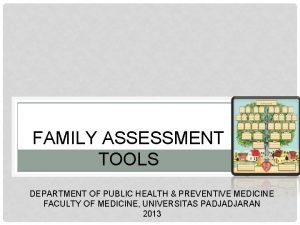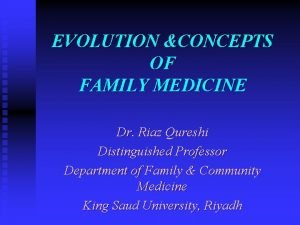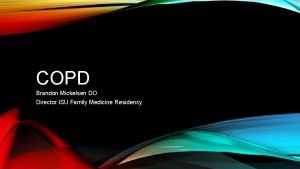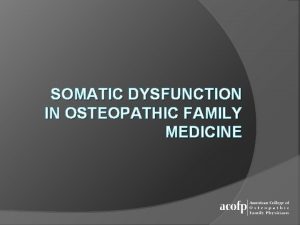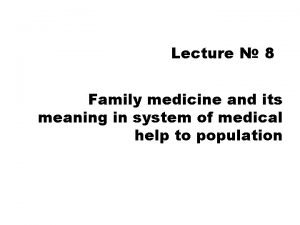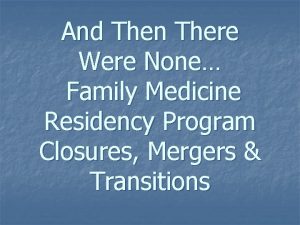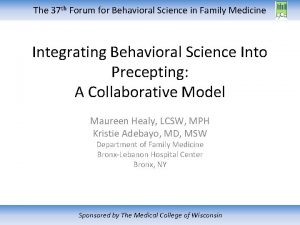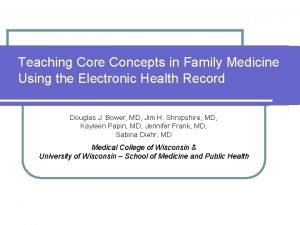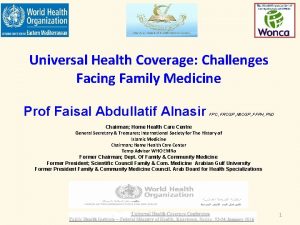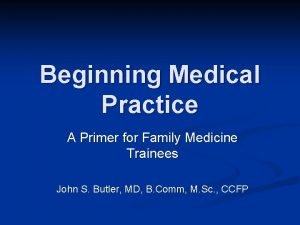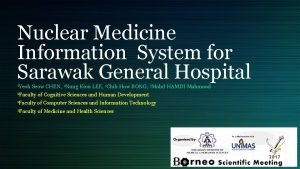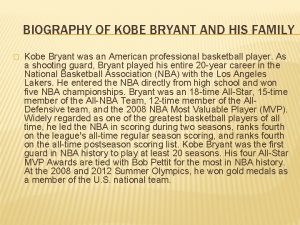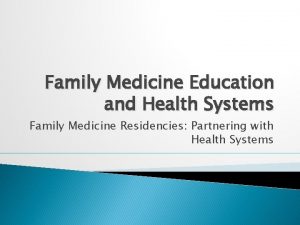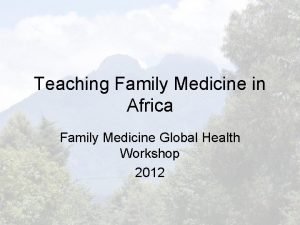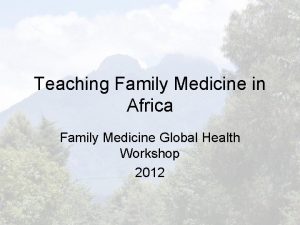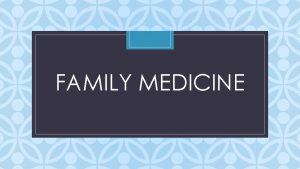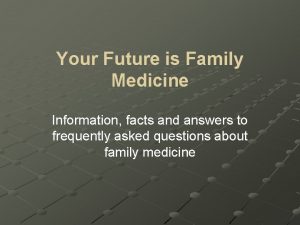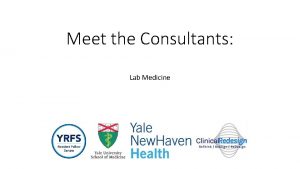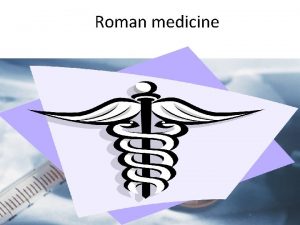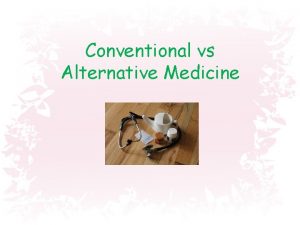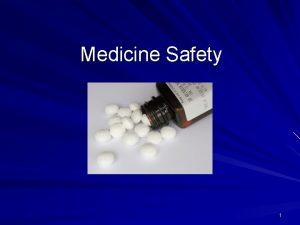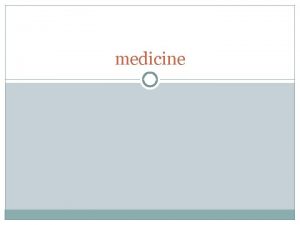Meet Family Medicine Information facts and answers to













































- Slides: 45

• Meet Family Medicine • Information, facts, and answers to frequently asked questions about Information, facts, and answers to frequently careers in family medicine asked questions


What is Family Medicine? The four C’s of primary care cover some of the basics: • First contact • Continuous • Comprehensive • Coordinated

The Four C’s: Not Enough 5. Context in care—Family Medicine includes understanding health as a result of family and community

The Primary Care Specialties: What’s the Difference? Sees infants, kids? Family Medicine Pediatrics Internal Medicine Med-Peds Sees adults? Comprehensive women’s health procedures? Options for specialization? Highest number of graduates practicing primary care?

More than half of all office visits in the US are to a primary care physician. Primary care physician Nonprimary care physician Source: Centers for Disease Control and Prevention. Ambulator Care Use and Physician Visits, 2013. https: //www. cdc. gov/nchs/fastats/physician-visits. htm. Accessed September 1, 2017.

Who Are Patients’ Primary Care Physicians? Physician characteristic Percentage of total office visits Family Medicine 21. 8 Internal Medicine 14. 3 Pediatrics 11. 0 Centers for Disease Control and Prevention. National Ambulatory Medical Care Survey: 2014 State and National Tables. https: //www. cdc. gov/nchs/data/ahcd/namcs_summary/2014_namcs_web_tables. pdf. Accessed September 1, 2017.

Is There a “Primary” Primary Care Specialty? . Care for every patient. At the center of the patient lifecycle. Adaptable, meeting future needs. Trainees want to be in primary care. Advancing evidence that matters to patients.

Family Physicians Specialize in Care for All Selected Area of Clinical Service Percentage of Family Physicians Who Perform Chronic care management 81. 8 Adolescent medicine 80. 1 Geriatric medicine 76. 9 Care of infants and children 73. 1 Urgent care 55. 2 Inpatient care 36. 2 Obstetrics 17. 1 AAFP, Family Medicine Facts, 2016.

Family Medicine and Procedures Selected clinical procedure Percentage of physicians who perform Skin procedures (e. g. , biopsies) 73. 4 Musculoskeletal injections 64. 2 Spirometry 34. 3 Endometrial sampling 30. 0 Radiography 25. 2 Colposcopy 16. 1 Cosmetic procedures 8. 6 Ultrasound imaging (OB) 7. 6 Vasectomy 7. 6 Cardiac stress testing 6. 7 Ultrasound imaging (non-OB) 6. 0 Echocardiography 4. 1 Allergy testing 3. 7 Flexible sigmoidoscopy exam 3. 6 Esophagogastroduodenoscopy 2. 3 Nerve conduction study 1. 9 AAFP, Family Medicine Facts, 2016.

Comprehensive Care: It Makes a Difference Physician comprehensiveness Cost and hospitalizations Source: Bazemore A, Petterson S, Peterson LE, Phillips RL Jr. More comprehensive care among family physicians is associated with lower costs and fewer hospitalizations. Ann Family Med. 2015; 13(3): 206 -2013.

Primary Care Delivers Complex Care 100 90 80 70 60 50 40 30 20 10 0 One diagnosis Two diagnoses Primary care Three diagnoses Specialty care Source: Moore M, et al. Prim Care Diabetes. 2016; 10(4): 281 -286. Four diagnoses

Putting It All Together First Contact, Continuous, Comprehensive, Coordinated + Context

Taking Action on Population Health Quiz Which would save more lives: social change or continued investment in medical advances?

Taking Action on Population Health Patients need more than medicine Connections to community resources, help navigating the health care system, care management from primary care teams Family physicians care for special populations Refugees, patients who are homeless, LGBT persons, minorities

Primary Care Health Professional Shortage Areas (1999)

Primary Care Health Professional Shortage Areas if Pediatricians Left

Primary Care Health Professional Shortage Areas if Internists Left

Here is the original map one more time: (1999)

Now Here It Is without Family Physicians



Med-Peds Workforce A 2015 survey found: • 63. 2% of the Med-Peds workforce identified as primary care physicians • Physicians less than 14 years out of medical school were less likely to be in primary care • Many in hospital medicine considered themselves primary care physicians Source: Donnelly MJ, Thornton SC, Radabaugh CL, et al. Characteristics of the combined internal medicine-pediatrics workforce. Am J Med. 2015; 128(12): 1374 -1379.

Why are More Internal Medicine Graduates Choosing to Specialize? The answer is in the training. Majority of IM education happens in the hospital and has subspecialty tilt. 39. 6% of IM residents in a primary care program planned to practice primary care

The Family Medicine Residency Experience • Three to four years • Each program offers something unique Major areas of training: Maternity care, hospital medicine, outpatient care, mental health care, surgical procedures, community medicine, end-of-life care With Continuity of Care as a continual focus.

What if I Have a Particular Area of Interest? Selected Fellowships for Family Medicine Graduates Combined Residency Programs 20 -Plus Fellowship Options Certificates of Added Qualification Adolescent medicine Integrative medicine Behavioral medicine International health Clinical informatics Maternity care/obstetrics Community medicine Pain management Emergency medicine Preventive medicine Faculty development Research Geriatrics Rural medicine Health policy Sleep medicine Hospice/palliative care Sports medicine Hospitalist medicine Substance abuse Human immunodeficiency virus/AIDS care Urgent care

How Many More Primary Care Physicians Do We Need to Train?

How Many More Primary Care Physicians Do We Need to Train? >44, 000 Source: Annals of Family Medicine, 2015.

Hope for the System: Team-Based Care Collaboration makes anything possible.

Primary Care Teams What is team-based care? It’s relationship based: Two or more professionals working together to improve patient care. It’s flexible: Built around patient population needs. It’s patient centered: Greater opportunity for expanded office access, greater focus on education and self-management. It’s physician dependent: Value of model stems from clinical efficiency and expertise. Complex patients get physicians’ increased focus.

What Can I Expect From a Career in Family Medicine? • Average income in 2017: $209, 000 (up from $175, 000 in 2013) • Average starting salary in 2017: $200, 000 to $225, 000 • Signing bonuses up to $30, 000 • Most recruited specialty for more than 10 years • Primary care–specific loan repayment assistance Sources: Merritt Hawkins (2017), Medscape (2015)

Burnout: Am I Going to Be at Risk? In 2017, 55% of family physicians told Medscape that they were burning out. Rates of burnout in other specialties ranged from 42% to 59%. It’s not the doctors. It’s the system. FACTOR 1: Administrative complexity FACTOR 2: Documentation requirements + tools that need to catch up FACTOR 3: Payment incentives that emphasize the wrong measures of care Family physicians know what needs to change. Policymakers want their solutions. The AAFP consistently advocates for improvement of the family physician work environment.

In Family Medicine You Can Take Care of Yourself, Your Patients, and Your Family. 75% of AAFP members reported being satisfied or very satisfied with their careers. 79% said they have a good sense of well-being. (2017) Use your skills: broad scope of practice is associated with lower levels of burnout. Family physicians have long-term career flexibility because of training scope and high recruitment demand. Practice model plays a role in well-being. In primary care there are many clinic styles to choose from.

Career Settings • • • Office practices Hospitals Nursing homes Community health centers Urgent care centers Emergency rooms University-based health centers Rural and urban International Health care system leadership Government

Presenter: Want to add information about delivery of care in your talk? See our slide collection “How Care Happens” in the AAFP’s presentation resource center at www. aafp. org/medical-schoolresidency/fmig/presentations. html and mix in the context here. If not, delete this slide and continue.

Portrait of a Week in Practice • Hours worked: 47 • Most of time spent: with patients • Weeks worked per year: 47 • Percent of family physicians who work part time: 11. 4 Source: AAFP, 2015

Community Trust 86% of Americans agree: primary care leads to better health And that it also represents: -Higher-quality health care -Greater cost-effectiveness Source: Health is Primary, 2017

Portrait of Family Medicine in the Future Building on a Strong Past First professional organization (eventually known as AAFP) formed 1947 Family practice approved as specialty 1969 Folsom Commission: “Health Is a Community Affair” 1966 Starfield, et al publish on FM’s unique effect on lives saved in a community 2005 Expansion of hospital privileges; schools rewarded for graduating generalists 1980 s #FMRevolution: physicians reclaim counterculture origins 2010 s Affordable Care Act elevates preventive care, creates new payment incentives 2010 Record number of students match into FM 2016

Portrait of Family Medicine in the Future What can you expect to change? • • Growing salary Increasing demand Health care reform emphasizing primary care Urban centers will have higher populations Population is aging High tech, high touch skillset shaping care delivery “Chronic care will unseat acute care”

Presenter: Want to add information about the future of health care in your talk? See our slide collection “Health Reform Highlights” in the AAFP’s presentation resource center at www. aafp. org/medical-schoolresidency/fmig/presentations. html and mix in the context here. If not, delete this slide and continue.

People don’t need more health care; They need more family physicians. From newborns to older patients, everyone there are more primary care physicians. is healthier when Source: Starfield B, Shi L. Policy relevant determinants of health: an international perspective. Health Policy 2002; 60(3): 201 -218 Patients actually live longer when family physicians are added to a community compared with all other physicians. Source: Starfield B, Shi L, Macinko J. Contribution of primary care to health systems and health. Milbank Q. 2005; 83(3): 457 -502.

What Do You Look Forward to As a Physician? Intellectual challenge of the undifferentiated patient? Forming relationships with patients? Public health implications? The physician lifestyle? Following a patient through treatment? Using scientific evidence in practice? Stature in the community?

Presenter: Want to show students real-world examples of the possibilities in family medicine? See our slide collection “Meet Family Physicians” in the AAFP’s presentation resource center at www. aafp. org/medical-schoolresidency/fmig/presentations. html and mix in the context here. If not, delete this slide and continue.

Five Ways to Find Family Medicine 1. Identify mentors early 2. Go to National Conference 3. Get involved in the campus Family Medicine Interest Group 4. Join AAFP (free; includes Board Review) 5. Explore the scope: read American Family Physician journal and listen to AFP Podcast

Questions? "I love being a generalist and being able to speak with experience about a wide range of clinical topics. I also appreciate the ability to bring clinical experience to research and health policy discussions. ” —Dr. Frederick Chen “…Providing care to underserved populations also brings a similar sense of purpose and pride. I entered the field of medicine because I wanted to help people and to make a difference. ” —Dr. Devry C. Anderson “This is not a job. It is a lifestyle choice that challenges your intellect daily and your ability to interact and develop relationships based on mutual trust to promote the health and wellbeing of your patients. “ —Dr. Flora Sadri. Azarbeyejain
 Till we meet till we meet at jesus feet
Till we meet till we meet at jesus feet Duke medicine grand rounds
Duke medicine grand rounds Multiplication facts and division facts
Multiplication facts and division facts Internal medicine jeopardy questions and answers
Internal medicine jeopardy questions and answers Types of family in community medicine
Types of family in community medicine Principles of family medicine
Principles of family medicine Halifax family medicine residency
Halifax family medicine residency Meritus medical center family medicine residency
Meritus medical center family medicine residency Family medicine procedures
Family medicine procedures Milestones family medicine
Milestones family medicine Best family medicine board review
Best family medicine board review Elements of primary health care
Elements of primary health care Wonca definition of family medicine
Wonca definition of family medicine Psychiatry shelf exam percentiles
Psychiatry shelf exam percentiles Family ecomap example
Family ecomap example St cloud family medicine
St cloud family medicine Af williams clinic
Af williams clinic Kaiser permanente san diego family medicine residency
Kaiser permanente san diego family medicine residency Family medicine in ethiopia
Family medicine in ethiopia Cabarrus family medicine concord nc
Cabarrus family medicine concord nc Uthscsa internal medicine residents
Uthscsa internal medicine residents Slu ent residents
Slu ent residents Screem family medicine
Screem family medicine 10 principles of family medicine
10 principles of family medicine Isu family medicine
Isu family medicine Somatic dysfunction in osteopathic family medicine
Somatic dysfunction in osteopathic family medicine Family medicine meaning
Family medicine meaning Illinois masonic family medicine residency
Illinois masonic family medicine residency Screem res scoring
Screem res scoring Principle of family medicine
Principle of family medicine Challenges facing family medicine
Challenges facing family medicine Primer family medicine
Primer family medicine Nuclear medicine information system
Nuclear medicine information system Difference between nuclear family and joint family
Difference between nuclear family and joint family Finland facts and information
Finland facts and information Shake instrument family
Shake instrument family Biography on kobe bryant
Biography on kobe bryant Family economics and financial education
Family economics and financial education Doris norton
Doris norton Varies from family to family on the periodic table.
Varies from family to family on the periodic table. Blended family vs binuclear
Blended family vs binuclear Data is a collection of raw facts and figures
Data is a collection of raw facts and figures Meet and greet agenda
Meet and greet agenda Meet raisa last night and _____ signed _____ t-shirt. *
Meet raisa last night and _____ signed _____ t-shirt. * Examples of charging by contact
Examples of charging by contact 3 market need
3 market need




